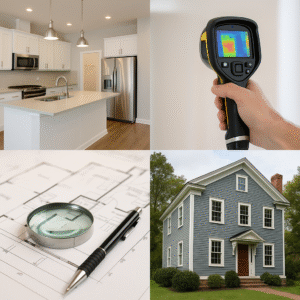How to Integrate Smart Technology into Your Household Appliances
In today’s fast-paced world, technology has become an integral part of everyday life, and the home is no exception. One...

In today’s fast-paced world, technology has become an integral part of everyday life, and the home is no exception. One of the most exciting advancements in recent years is the integration of smart technology into household appliances. Smart appliances make daily tasks more convenient, efficient, and even eco-friendly. Whether it’s adjusting your thermostat from your smartphone or setting your washing machine to start automatically, these devices can transform your home into a more connected, streamlined space.
If you’re looking to integrate smart technology into your household appliances, this guide will walk you through the benefits and steps to create a smarter home.
1. Why Integrate Smart Technology into Household Appliances?
Before diving into the process, it’s important to understand the benefits of adding smart technology to your appliances. These include:
- Convenience: Smart household appliances can be controlled remotely through smartphone apps, voice assistants, or even via automation. Imagine preheating your oven on your way home or adjusting your thermostat from the comfort of your bed.
- Energy Efficiency: Many smart appliances are designed to optimize energy use, automatically adjusting settings based on your habits. This can help lower your energy bills while contributing to environmental sustainability.
- Time Savings: With features like remote control, scheduling, and automation, smart appliances allow you to perform tasks like washing clothes, cooking, or cleaning without being physically present, freeing up time for other activities.
- Enhanced Control and Monitoring: Smart appliances often come with real-time monitoring capabilities. For example, a smart fridge will alert you when a door is left open, while a washing machine might notify you when your laundry is done.
2. Start with Your Wi-Fi Network:
Before upgrading any appliances, it’s crucial to ensure your home Wi-Fi network is up to the task. Most smart appliances require a stable, strong internet connection to function effectively. A Wi-Fi router with a good range and speed is essential, particularly if you plan on connecting multiple devices.
Consider upgrading to a mesh Wi-Fi system if you have a larger home or if your current router struggles with coverage in certain areas. The stronger and more reliable your internet connection, the better your smart appliances will perform.
3. Choose the Right Smart Appliances:
When it comes to integrating smart technology, there are a wide variety of household appliances to choose from. Here are some of the most common appliances that benefit from smart technology:
- Smart Thermostats: These allow you to control your home’s temperature remotely and set schedules. Popular options like Nest or Ecobee can learn your habits over time, adjusting temperatures based on your daily routines, thus saving energy.
- Smart Refrigerators: Modern refrigerators now come with touchscreens, cameras that let you see inside the fridge from your phone, and even voice assistants that can help you create shopping lists or order groceries online.
- Smart Washing Machines and Dryers: Brands like Samsung and LG offer washers and dryers with Wi-Fi connectivity, allowing you to monitor your laundry remotely, schedule cycles, and receive notifications when your laundry is done.
- Smart Ovens and Microwaves: With these appliances, you can preheat your oven, control temperature settings, and monitor cooking times remotely via your smartphone. Some models even allow voice control through platforms like Amazon Alexa or Google Assistant.
- Smart Dishwashers: Like smart washing machines, dishwashers can be controlled remotely to start or stop cycles, and you can receive notifications when the cycle is complete. These dishwashers can also be programmed to run during off-peak hours to save on energy costs.
- Smart Vacuums: Robotic vacuums, such as those from Roomba or Eufy, can be scheduled to clean your home while you’re away, and some models can even be controlled via smartphone or voice commands.
- Smart Lighting: Although not an appliance in the traditional sense, integrating smart bulbs into your home can be an easy and inexpensive first step. You can control the brightness and color of your lights remotely, set schedules, and even use motion sensors to automatically turn lights on and off.
4. Install the Smart Appliances:
Once you’ve selected the smart appliances that best suit your needs, the next step is installation. Most smart appliances are designed to be easy to set up, but some might require professional installation. For example, a smart oven or washing machine may need specialized connections.
Follow these steps for a smooth installation process:
- Follow the manufacturer’s instructions: Each appliance will come with detailed setup guides. Many brands offer mobile apps that help you through the setup process step-by-step.
- Connect to your Wi-Fi: During the setup process, you’ll need to connect your appliance to your home’s Wi-Fi network. Make sure your Wi-Fi is stable and that you follow the instructions carefully for proper connectivity.
- Install the necessary apps: Most smart appliances require an app to operate. Download the app corresponding to the appliance and create an account if necessary.
- Pair with voice assistants: If your appliance is compatible with Amazon Alexa, Google Assistant, or Apple HomeKit, follow the steps to connect it with your preferred voice assistant for hands-free control.
5. Customize and Automate:
After installing your smart appliances, the next step is to personalize them to your needs. Many smart appliances allow you to set preferences, create schedules, and automate tasks. For example:
- Smart thermostats can learn your heating and cooling preferences, adjusting temperatures based on your habits.
- Smart washing machines allow you to schedule wash cycles, so they run when it’s most convenient for you.
- Smart ovens enable you to set cooking times, adjust temperatures, and even check on cooking progress from your smartphone.
You can also automate certain appliances to work together. For instance, you could program your lights and thermostat to turn off when you leave the house or set your washing machine to run when electricity rates are lower.
6. Monitor and Maintain Your Smart Appliances:
Once your appliances are set up and automated, it’s important to keep an eye on their performance. Many smart appliances come with maintenance alerts, letting you know when to change a filter, clean the unit, or perform other maintenance tasks. You can monitor these notifications via your smartphone, ensuring your appliances always function at their best.
Some smart appliances also track their usage and offer insights into energy consumption, which can help you further optimize your home’s efficiency.
7. Stay Up to Date with Software Updates:
To ensure your smart household appliances continue to perform optimally, it’s important to keep them updated. Most smart appliances receive periodic software updates that introduce new features, enhance security, and improve functionality. Make sure you enable automatic updates on your appliances to keep them running smoothly and securely.
Conclusion:
Integrating smart technology into your household appliances offers countless benefits, including convenience, energy savings, and greater control over your home environment. With a little planning and the right equipment, you can transform your home into a smart, connected space that caters to your needs and lifestyle. Whether you’re looking to simplify chores, improve energy efficiency, or simply add a touch of convenience to your daily routine, smart appliances can help you achieve it all. Take the leap into the future of home living and start enjoying the benefits today!







